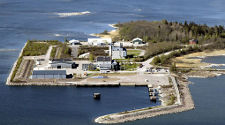
The Swedish Radiation Safety Authority (SSM), and its predecessors SKI and SSI, are responsible for reviewing safety assessments submitted by Swedish Nuclear Fuel and Waste Management Company (SKB) in support of the development of its disposal facilities, which comprise both low and intermediate level waste (LILW) and spent fuel (SF). In some instances those assessments have been an integral part of a licence application. Both AMBER and QPAC have been used repeatedly to undertake calculations in support of these reviews.
Review of SF Safety Assessments
In 2006, SKB submitted the SR-Can safety assessment in support of the development of a final repository for spent nuclear fuel. An important element of the authorities' review process was the commissioning of three international expert groups to carry out independent reviews of SR-Can, with a focus on the integration of site data, understanding of the engineered barrier system (EBS), and methodology for safety analysis. Quintessa staff played key role in this review process, with David Savage acting as chair of the EBS review group (published as SKI Report 2008:10), and Michael Egan as secretary for the methodology review group (published as SSI Report 2008:05).
Following the submission of the SR-Site safety assessment associated with the licence application for the development of a spent fuel disposal facility at Forsmark in 2011, Quintessa again played a key role supporting regulatory review in the area of consequence analyses. Staff undertook independent reviews of the radionuclide transport aspects of the assessment modelling (SSM Report 2012:55; SSM Report 2014:55), and also the representation of the biosphere in the assessment (SSM Report 2014:34; SSM Report 2014:54).
Review of LILW Safety Assessments
In 2014, SKB submitted the SR-PSU safety assessment as part of the licence application to extend and continue to operate their SFR facility in Forsmark, which is a LILW disposal facility. Once again, staff at Quintessa played a key role supporting regulatory review in the areas of geochemical review, reactive transport modelling, radionuclide transport modelling and biosphere modelling (SSM Report 2016:09; SSM report 2017:28; SSM Report 2017:30; SSM Report 2017:33). Quintessa was tasked with re-implementing key aspects of SKB’s radionuclide transport and biosphere models using the AMBER code and with developing independent models of the evolution of engineered barrier materials using the QPAC code. The associated findings have been published in SSM report 2019:16.
SE-SFL is the latest safety evaluation of the disposal concept development for long-lived low and intermediate level waste in Sweden (SFL). The purpose of SE-SFL is to provide inputs to the next steps in the development of the repository, in particular, to evaluate the potential for the SFL repository concept to meet regulatory requirements for post-closure safety. SSM has contracted external experts to support its review of SE-SFL. The general objective has been to support SSM’s assessment of the evaluation, provide feedback on the continued development of the SFL repository concept, and review the continued development of SKB’s approach to assessment-level modelling. Quintessa provided independent reviews of SKB’s approach to modelling concrete degradation, radionuclide transport in the near-field, and biosphere dose assessment. The findings of these reviews are contained in SSM Report 2021:13.
